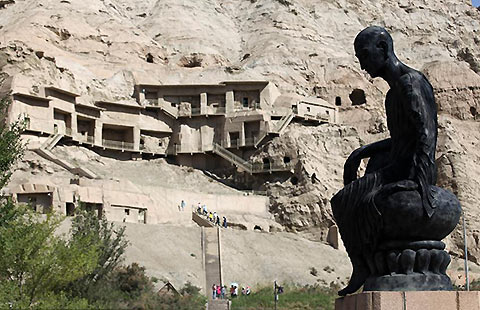Move over Columbus, discovering America was already old hat
Updated: 2015-07-15 11:20
By Chris Davis(China Daily USA)
|
||||||||
"In August 1492, Columbus sailed the ocean blue; October 12th they sighted land, and set their feet upon new sand..."
So goes the children's nursery rhyme about the discovery of America, but Columbus' role in it might get turned on its head, thanks to John A. Ruskamp Jr, who has reported finding an extraordinary, game-changing archaeological treasure hiding in plain sight at New Mexico's Petroglyph National Monument.
The "monument" is actually a 17-mile-long volcanic basalt escarpment that stretches across Albuquerque's western horizon, a wall ideal for etching long-lasting Stone Age graffiti. More than 24,000 petroglyphs - or graphic symbols - are gouged into its surface, all believed to have been put there starting 700 years ago, first by the original Native American residents and later by the Spanish settlers. Until now.
Hiking a trail there one day, Ruskamp noticed some high-placed "glyphs" that looked out of place. The symbols didn't look Spanish, and showing photos to experts, he learned that they weren't Native American either.
"These images do not readily appear to be associated with local tribal entities," Michael F. Medrano, PhD, chief of the division of resource management for the monument, pronounced after studying the glyphs on site. He added that based on the amount of patina that had formed on the scratches, they "appear to have antiquity to them".
Ruskamp showed the images to experts on Chinese calligraphy and bingo.
The symbols corresponded to the oracle-bone style of ancient Chinese writing that was "disappeared" by royal decree from mankind's memory around 1046 BCE after the fall of the Shang Dynasty and remained invisible in history's dustbin until it was rediscovered in 1899.
Research suggested that the style of writing was transitional, combining oracle-bone style with what was coming next.
One striking series of glyphs paints an intriguing mystery. In the first box, the characters - reading top to bottom and right to left - Yin, Jiu, Xun, Jiu, translate as: ("Set apart for 10 years together"), the next box: Chi, Hui, Hui, Ri (" declaring to return, the journey completed, to the house of the Sun").
In his paper, Ruskamp mentions the ancient Chinese text Shan Hai Jing, from at least the fourth century BCE. In it is a "somewhat fanciful" account of an ancient expedition to a land far beyond the East Sea (Pacific Ocean) to a land where the Sun and Moon rise and where there is an abyss called the "Big Chasm" (Grand Canyon?).
Another translation: "Geng (the date of the seventh Chinese Heavenly Stem) Jie (kneel down in reverence) Da (to a superior) Quan (a sacrificial dog) Xian (deceased-ancestor worshiping) Da Jia (the third king of the Shang Dynasty)."
The Shang Dynasty ran from 1600 to 1046 BC, which would put King Da Jia, I'm guessing here, somewhere around 1520?

Ruskamp said the messages were apparently not intended as a public announcement or even to be read. He cites MacArthur Genius Award-winning oracle-bone writing expert David N. Keightley, who wrote: "The incising mattered more than the writing," as they were "inscribed to leave a record rather than a document the importance of the inscriptions was that they were there, that they existed, not that they were read."
The biggest bugaboo of archaeology, of course, is putting dates on things, especially something as amorphous as a scratch in a rock.
"In the absence of sufficiently precise absolute dates, arrived at by carbon-14 dating or some other method," Keightley says, "the inscriptions themselves provide our most reliable evidence for relative dating."
And analyzing that - readable sequences of 2,500-year-old Chinese scripts on the rocks of North America - Ruskamp concludes:
"Here is demonstrable epigraphic proof that Chinese explorers not only reached the Americas long ago, but that they interacted positively with Native North American people over an extended period."
So maybe sometimes history really is written in stone.
Contact the writer at chrisdavis@chinadailyusa.com.

 Heavy downpour hits SW China
Heavy downpour hits SW China
 Wan Li: A life in photos
Wan Li: A life in photos
 22 World Heritage Sites in China along the Silk Road
22 World Heritage Sites in China along the Silk Road
 A day of masks
A day of masks
 France celebrates Bastille Day
France celebrates Bastille Day
 China's northernmost high-speed railway enters trial operation
China's northernmost high-speed railway enters trial operation
 Eight industries the shared economy will transform
Eight industries the shared economy will transform
 Photographer in search of his 'homeland' in post-Three Gorges landscape
Photographer in search of his 'homeland' in post-Three Gorges landscape
Most Viewed
Editor's Picks

|

|

|

|

|

|
Today's Top News
China's GDP grows by 7%
Japan passes disputed bill
Petcoke called key in pollution fight
Service sector bolsters China’s GDP despite stock woes
Bush, Clinton dominate early presidential fundraising
Tiny Pluto sports big mountains, New Horizons finds
Greek parliament approves debt deal and first reforms
China's Internet giants reprimanded over obscene clip
US Weekly

|

|






